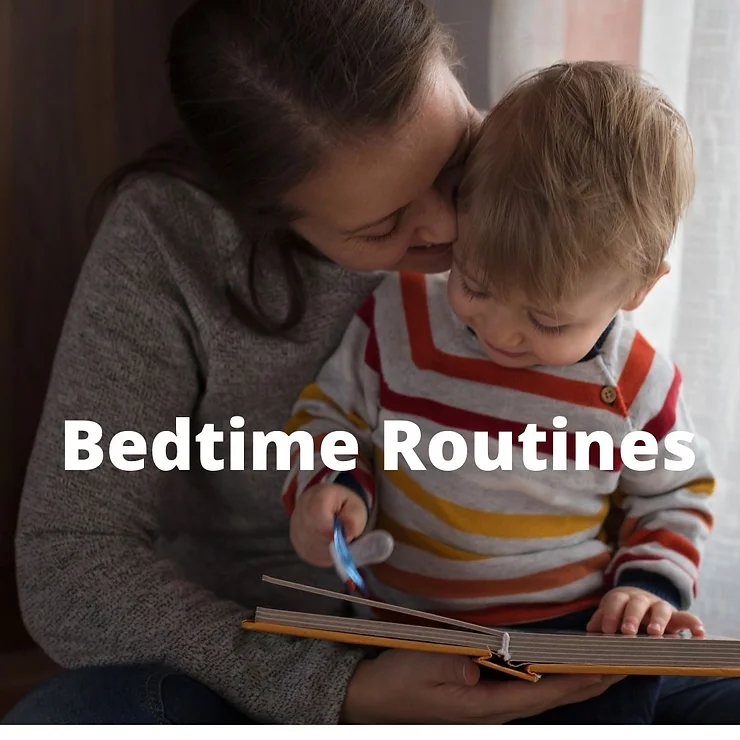Bedtime Routines
I love bedtime routines! Mostly because I know it will end with my children in their own beds and ready for sleep – and I can finally have a bit of time to myself. 🙂
Also, it’s that time of day when everything the kids do seems extra adorable and we get a final bit of real connection. My own kids are a little more open to kisses and snuggles during this time too while we prepare to separate for the night. It’s sweet!
I love learning about other family’s bedtime routines because they are all so similar, a touch unique, always sweet, and a glimpse into another family’s most precious time of the day. I always ask for the details around other family’s bedtime routines when we’re working together one-on-one, and my heart just about melts every single time.
Routines in general are enormously helpful tools for easing transitions with children. The trick is that in order for a routine to be helpful, it needs to be used consistently.
A bedtime routine helps to ease the transition from wake time/play time to sleep time. It’s a set of the same simple steps that are performed in the same order every single night before bed. This allows our children to learn exactly what to expect from us, which in turn helps them to feel very safe. A child who feels very safe is likely to have an easier time falling into a deep and blissful sleep!
An ideal bedtime routine is mostly calm one on one time with a caregiver and consists of steps that are mostly necessary in order to prepare for bed, but should also include some bonding activities as well.
A Bedtime Routine for a Baby Might Look Something Like:
- Close the bedroom door, dim the lights, and turn on the white noise machine
- Change into a clean diaper and pajamas and sleep sack
- Offer the last feed of the day
- Read one book
- Sing one song
- Offer a final hug and kiss
- Confidently place them in their safe sleep space
- Say goodnight, turn off the lights, and leave the room
A Bedtime Routine for a Toddler or Preschooler Might Looks Something Like:
- Brush teeth
- Last potty trip
- Clean pull up and pajamas
- Silly play x3 min or duration of one song
- Dim the lights and turn on the white noise machine
- Read one book
- Sing one song or review one reason you love them
- Tuck in
- Final hug and kiss
- Say goodnight, turn off the lights, and leave the room
Bedtime routines can vary depending on your parenting style, sleep preferences, and choices, but there are five key elements I always recommend for parents who are working to improve their child’s healthy sleep habits.
ONE.
I recommend purposefully bringing energy levels down for a successful bedtime routine. For some children, it helps to start bringing the energy levels of the whole house down 10-20 minutes prior to the bedtime routine.
This might look like:
- closing window blinds
- turning off screens
- turning off unnecessary lights
- speaking slowly and taking mindful breaths
Our children feed off of our energy and some will have an easier time being calm themselves if the energy of the home comes down earlier in the evening. Some children will do well if you bring energy levels down just for the bedtime routine. Find what works best for your family.
TWO.
I recommend absolute consistency around the exact number of books or songs. One extra book or song might not feel like a big deal when you are soaking up all of the free cuddles at the end of the day. And no, it’s really not a big deal in the grand scheme of things. However, children are creatures of habit and if you sometimes read one book and other times read three books, you may be setting yourself up for a lot of protests and whining around the end of the book portion of your bedtime routine. It can really kill the calm vibe you were intending and it’s really not worth it.
THREE.
For the little ones – I recommend offering a last feed early on in the bedtime routine. For a baby who is still taking a bottle or nursing before bed, it’s very helpful to offer that last feed early in the routine to discourage your baby from falling asleep while eating. Babies who always fall asleep while eating are likely to think they also need to eat to fall asleep each time they wake up during the night as they naturally transition through sleep cycles. If sleeping through the night is a goal in your family, shifting that last feed earlier in the routine will go a long way toward helping your baby master this exciting skill.
FOUR.
I recommend ending the bedtime routine with your child still awake so they have the opportunity to practice falling asleep independently. A child who falls asleep independently at bedtime is going to have the skills to also fall asleep independently when they wake up in the middle of the night as they naturally transition through sleep cycles.
It will help to be purposefully calm and confident throughout the routine, and especially while you say goodnight at the very end. Fake it if you have to! Our children are always paying close attention to us and if they notice that we are acting anxious and unsure, they are likely to feel the same way!
FIVE.
I recommend using an abbreviated version of your bedtime routine before all naps during the day as well. The bedtime routine is always going to be a bit longer to include all of the necessary steps to prepare for bed and to make this bigger transition as easy as possible for your child. The nap time routines should be shorter, but still very similar to familiarize your child with the very consistent process that will ease the transition between play time and sleep time.
The presence of a consistently used and predictable bedtime routine goes a long way toward facilitating healthy sleep habits for babies and young children. Mostly, it’s made up of steps that are necessary for sleep anyway. Make sure those steps are performed in the same order every night, add in one or two brief bonding activities, and end it confidently with your child falling asleep on their own. There, you have the perfect bedtime routine that you and your child will love.
If bedtime, naps, or sleeping through the night is a struggle for your child, take a look at my Top Five Tips for Healthy Sleep.
And if you’d like to explore working one-on-one with me to teach your child sustainable healthy sleep habits, schedule a free 15 minute discovery call with me!

